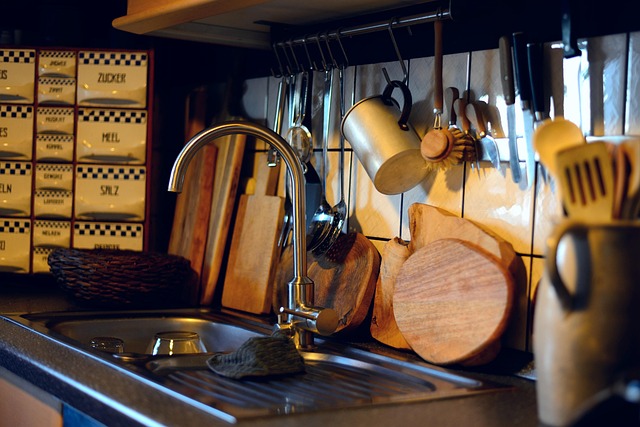When remodeling your kitchen, prioritize sustainability by choosing eco-friendly materials like recycled wood, bamboo, linoleum, and cork, which reduce waste and contribute to an energy-efficient space. Install low-flow fixtures and select Energy Star-rated appliances to conserve water and electricity. Beyond recycled materials, switch to energy-efficient appliances like LED lighting and efficient dishwashers/refrigerators to significantly reduce utility bills and environmental impact. These strategies transform your kitchen into a sustainable hub that minimizes your carbon footprint while offering durability, style, and unique aesthetics.
“Unleash your inner eco-warrior with a green kitchen remodel! As an eco-conscious homeowner, you have the power to transform your space into an environmental haven. This guide explores sustainable choices that cater to your style and reduce your ecological footprint. From selecting recycled materials for a sleek, natural look to implementing energy-efficient appliances and smart technology, every detail counts. Discover innovative design strategies for optimal light, ventilation, and storage, all while creating a kitchen that’s both beautiful and kind to the planet.”
- Choosing Sustainable Materials for Your Kitchen Remodel
- – Exploring eco-friendly alternatives to traditional materials
- – Benefits of using recycled and natural resources in kitchen design
- Implementing Energy-Efficient Appliances and Fixtures
Choosing Sustainable Materials for Your Kitchen Remodel
When remodeling your kitchen, opt for sustainable materials that align with your eco-conscious lifestyle. Consider using recycled or reclaimed wood for countertops and cabinets, which reduces waste and gives a unique character to your space. Bamboo is another excellent choice as it grows quickly and sustainably. For flooring, choose options like linoleum or cork, which are both durable and made from natural, renewable materials. These choices not only benefit the environment but also contribute to an energy-efficient kitchen that’s kind to your wallet in the long run.
Moreover, focus on low-flow fixtures and appliances to conserve water. Install efficient faucets and showerheads that limit water usage without compromising performance. Opt for Energy Star-rated refrigerators, dishwashers, and ovens, which consume less electricity. These simple yet powerful changes transform your kitchen into a more sustainable hub, setting the stage for an eco-conscious home.
– Exploring eco-friendly alternatives to traditional materials
Eco-conscious homeowners looking to remodel their kitchens have a plethora of green options to choose from, beyond the standard recycled materials. One key area to explore is switching to energy-efficient appliances and fixtures. Modern technologies offer powerful alternatives to traditional models, many of which consume significant amounts of energy. For example, LED lighting uses up to 75% less electricity than incandescent bulbs while providing comparable light quality. Energy-efficient dishwashers and refrigerators not only reduce utility bills but also minimize environmental impact by consuming less water and power.
Additionally, substituting conventional materials with eco-friendly ones can make a substantial difference. Bamboo, for instance, is a rapidly renewable resource that serves as an excellent alternative to hardwood flooring. It grows quickly and sustainably, making it a responsible choice for homeowners seeking to reduce their carbon footprint. Recycled glass and stainless steel are other versatile options available for countertops and backsplashes, offering durability and style while minimizing waste sent to landfills.
– Benefits of using recycled and natural resources in kitchen design
Using recycled and natural materials in kitchen design offers eco-conscious homeowners a chance to create beautiful, sustainable spaces that also boast energy-efficient features. These materials, such as reclaimed wood, recycled glass, and upcycled appliances, not only reduce waste but can also add unique character and warmth to the heart of the home. Beyond aesthetics, they often have lower environmental impacts due to reduced demand for new resources and shorter supply chains.
Moreover, many recycled and natural materials prove functional advantages. For example, bamboo, a fast-growing grass, makes durable and stylish flooring that’s highly resistant to water damage. Similarly, stone and ceramic tiles crafted from recycled content can significantly reduce a kitchen’s carbon footprint while providing excellent durability and easy maintenance. By opting for these green remodeling options, homeowners contribute to a more sustainable future, all while enjoying the benefits of energy-efficient kitchens that look and perform brilliantly.
Implementing Energy-Efficient Appliances and Fixtures
Homeowners looking to embrace green remodeling can start by making the switch to energy-efficient appliances and fixtures, a simple yet powerful step towards creating an eco-friendly home. This transformation begins in the heart of many homes: the kitchen. Energy-efficient kitchens are designed with innovative technology that reduces electricity consumption without compromising performance. From smart refrigerators that monitor food freshness and adjust settings accordingly, to dishwashers that use less water per load, these appliances not only lower utility bills but also minimize a family’s carbon footprint.
In addition to appliances, energy-efficient fixtures like LED lighting offer significant benefits. These lights consume far less power than traditional incandescent bulbs and have longer lifespans, reducing the need for frequent replacements. By incorporating such measures, homeowners can contribute to environmental conservation while enjoying modern conveniences that enhance their daily lives.
For eco-conscious homeowners looking to create an energy-efficient kitchen, green remodeling offers a sustainable and stylish path. By choosing recycled and natural materials and implementing energy-efficient appliances and fixtures, homeowners can reduce their environmental impact while enhancing their living spaces. These simple yet effective changes contribute to a greener planet and ensure a brighter future for all.
